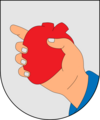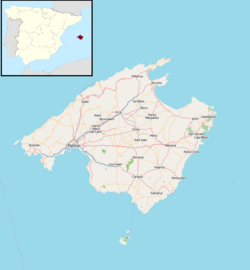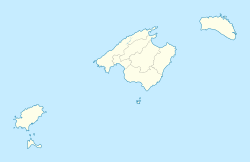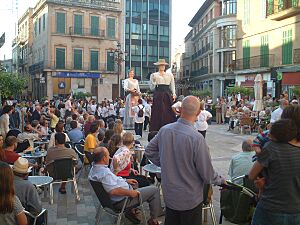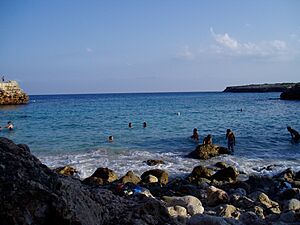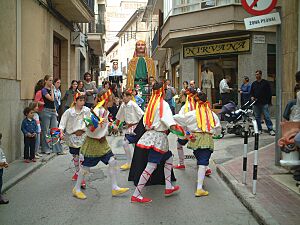Manacor facts for kids
Quick facts for kids
Manacor
|
|||
|---|---|---|---|
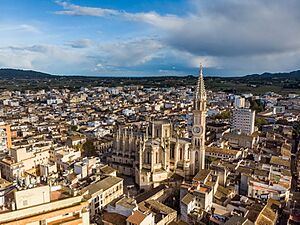 |
|||
|
|||
 |
|||
| Country | |||
| Autonomous community | |||
| Province | Balearic Islands | ||
| Comarca | Llevant | ||
| Judicial district | Manacor | ||
| Area | |||
| • Total | 260.31 km2 (100.51 sq mi) | ||
| Elevation | 80 m (260 ft) | ||
| Population
(2018)
|
|||
| • Total | 42,631 | ||
| • Density | 163.770/km2 (424.163/sq mi) | ||
| Demonym(s) | Manacorí | ||
| Time zone | UTC+1 (CET) | ||
| • Summer (DST) | UTC+2 (CEST) | ||
| Postal code |
07500
|
||
Manacor is a town and municipality located on the island of Mallorca. Mallorca is part of the Balearic Islands, which is an autonomous community of Spain. Manacor is the second-largest town in Mallorca, right after its capital, Palma.
The municipality of Manacor is famous for its beautiful tourist spots. These include Porto Cristo, where you can find the amazing Caves of Drach, and Cales de Mallorca. Manacor also hosts one of the busiest street markets on the island every Monday morning. The town is well-known for making high-quality wood furniture and artificial pearls.
Contents
History of Manacor
Ancient Times
People first lived in the Manacor area a very long time ago, between 2000 and 1200 BC. They used artificial caves as burial sites. You can still see ancient buildings, like the naveta, which were used as homes.
The megalithic Talaiot culture also left behind impressive structures. Some of the most famous are s'Hospitalet Vell and es Boc.
Before the Islamic rule, Manacor was already a town. Discoveries in Porto Cristo show it was a Roman port. Remains of old churches, like those at sa Carrotja and son Peretó, prove that Christian communities lived here.
Medieval and Early Modern Period
After James I of Aragon invaded, Nuño Sánchez was given the land of Manacor. In 1300, King James II officially made Manacor a municipality. Some old buildings from this time still stand, such as the Torre del Palau and fortified farmhouses like Torre de ses Puntes.
The name Manacor might come from an ancient language called Amazighe. However, the town's coat of arms, which shows a hand holding a heart, comes from a similar-sounding word in the Catalan language.
In 1414, Saint Vincent Ferrer visited Manacor. Later, in 1576, a convent and a beautiful baroque church were built in his honor.
Modern Era
In 1879, a railroad line connecting Inca to Manacor was opened. This helped the town grow.
Around 1890, construction began on the new main church, Nostra Senyora dels Dolors. It was built on the site of older churches, with the oldest possibly dating back to 1232. The church's bell tower is a symbol of Manacor and stands 75 meters tall.
In 1897, the first factory for artificial pearls, the famous Majorica, was founded. This made Manacor an important business and industrial center in the Llevant region. Manacor officially became a town in 1912.
During the Spanish Civil War in 1936, there was an attempt by republican forces to land on the shores of Porto Cristo. This was stopped by opposing forces. The mayor of Manacor at the time, Antoni Amer Llodrà, was killed during this conflict.
Geography of Manacor
Manacor's landscape is not very hilly. It has three main areas:
- The flat region called the Pla, where the town of Manacor is located.
- The Serra de Llevant, which has gentle hills.
- The Marina, an area with white sandy stone that slopes down to the sea.
Caves and Coastline
Because of the limestone rock, there are many caves in Manacor. The most famous and beautiful are the Dragon Caves and the Fishhook Caves. Near the coast, you can find one of Europe's longest underwater cave systems, the Gleda-Camp des Pou system, which is over 13 kilometers long.
Manacor's coast is dotted with many lovely coves. Some of these include S'illot, Cala Morlanda, Porto Cristo, Cala Anguila, Cala Mendia, and Cala Magraner.
Climate and Nature
Manacor has a Mediterranean climate. This means it has mild winters and hot summers. In July and August, it's usually hot and sunny, with about 11 hours of sunshine each day. Winters can be cool but are generally mild. The average yearly temperature is around 16 to 17 degrees Celsius.
About 20% of the area is covered by forests, mostly Pine trees. While there used to be many holm-oak forests, very few remain today.
Most of the land, about 74%, is used for farming. You'll see fields of almond trees, cereals, fig trees, carob trees, and vineyards. Farmers also grow vegetables like melon, pepper, and lettuce.
The Sa Cabana stream flows through the town of Manacor. This stream then joins the Na Borges stream, which is the most important one in the municipality.
Population of Manacor
Manacor has grown quite a lot over the centuries.
| Municipality | Population |
|---|---|
| 16th century | 5,000 approx. |
| 18th century | 7,000 approx. |
| Beginning of 20th century | 13,000 approx. |
Here are the populations of Manacor and its main towns in 2005:
| Centers | Population 2005 |
|---|---|
| Manacor | 25,324 |
| Porto Cristo | 6,385 |
| S'Illot-Cala Morlanda | 1,576 |
| Son Macià | 839 |
| Cales de Mallorca | 725 |
| Cala Murada | 624 |
| Cala Anguila-Cala Mendia | 296 |
| S'Estany den Mas | 139 |
| Total | 35,908 |
Economy of Manacor
Historical Economy
For a long time, until the 1800s, Manacor's economy was mainly based on farming. People grew cereals and grapes, and raised sheep. Making textiles and pottery were also important jobs. While there aren't as many huge farms today, some still exist, like Santa Cirga and Es Fangar.
The 19th century brought big changes. More factories opened to process farm products, and windmills and a liquor distillery appeared. From the mid-1800s, making furniture became one of Manacor's main industries. Pottery, liquors, and wines continued to be produced.
Modern Economy
The artificial pearl factory, Majorica, was very important throughout the 20th century.
Starting in the 1960s, tourism became a big part of Manacor's economy. Many people visit the beautiful beaches and caves. Today, construction and trade are also important parts of the local economy.
Local Products
Manacor is famous for its olive wood products. You can even visit factories in the town to see how they are made. The town is also well-known for its artificial pearl factories.
Culture and Traditions
Sant Antoni
This is the most popular celebration in Manacor. It starts on the evening of January 17th. A group of people dressed as Saint Anthony, a larger Demon, and smaller demons walk through the streets. They perform a dance that shows the temptations Saint Anthony faced. At night, bonfires are lit all over the municipality. People gather around them to sing, dance, and eat local pork products like "llangonisses" and "botifarrons".
The next day, the "Beneïdes" are celebrated. This is a parade of floats and all kinds of animals. The animals are blessed because Saint Anthony is their patron saint.
Fairs
The most important fairs are the Fires i Festes de Primavera (Spring Fairs and Festivals). They happen from late May to early June. During these days, there are many fun activities and exhibitions. The celebrations end with a parade of colorful floats.
Other fairs include the Fair of Saint James, who is the patron saint of Manacor, on July 25th, and the September Fair.
Theatre
Manacor has an active theatre scene, especially during the Fira de Teatre de Manacor, which usually takes place in September or October.
Traditional Dances
Moratons
This is a traditional dance with a mysterious past. It seems to have been created around 1855 for religious reasons, but it might be even older, possibly from the 16th century. The dancers wear costumes that look like those of old Barbary pirates. As they dance, they hit wooden pieces attached to their hands, knees, and stomachs.
The Moratons dance in May during the Sant Domingo celebrations.
Cossiers
Records of this ritual dance go back to the 18th century. The cossiers are a group of men who dance around a woman known as "The Lady." They wear colorful clothes and hats.
Today, the Cossiers open the Fires i Festes de Primavera.
Vimer (The Willow Tree)
This is a legend that has been told for over 100 years. The vimer (which means Salix viminalis or willow tree) is a special willow tree located at S'Hort des Correu, a country house outside Manacor. The legend says that this tree can heal children with hernias. To do this, children are passed through the branches of the tree at sunrise on Saint John's Day, which is June 24th.
Gastronomy
Manacor has some unique local foods. Suspiros de Manacor, also called Sospiros, are sweet, dry cookies often enjoyed with coffee or tea. Another special treat is the Pastís de Pobre, which means "Poorman Cake."
Sports
Besides popular sports like football, basketball, and volleyball, Manacor has many horse racing fans. Chariot races are held at the local hippodrome. Manacor is also the hometown of famous athletes, including former Spanish football player Albert Riera and tennis legend Rafael Nadal.
Famous People from Manacor
- Antoni Maria Alcover
- Toni Nadal
- Miguel Ángel Nadal
- Joan Binimelis
- Elena Gómez
- Sergi Guardiola
- Luis Ladaria
- Rafael Nadal
- Maria Antònia Oliver Cabrer
- Arnau Riera
- Albert Riera
Images for kids
See also
 In Spanish: Manacor para niños
In Spanish: Manacor para niños



